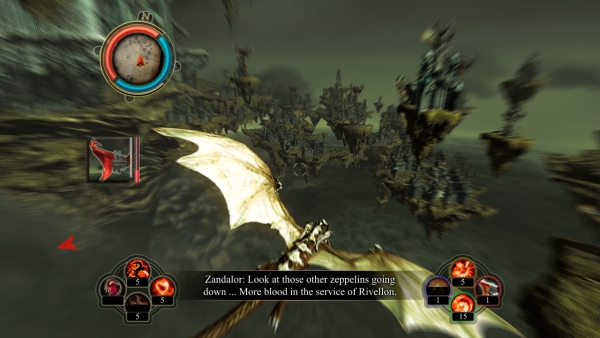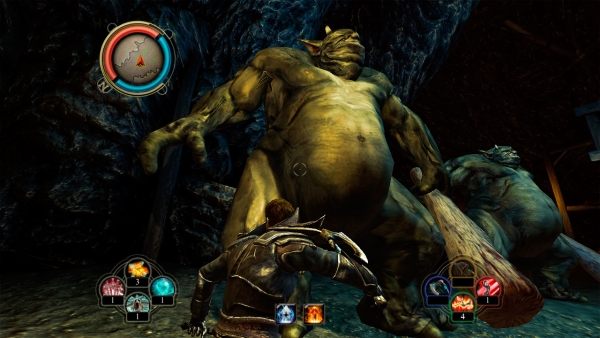
That’s right, I made a Slayer joke. It’s a fitting one for the main character – a Dragon Slayer – in Divinity II: The Dragon Knight Saga, Larian Studio’s compilation of Divinity II: Ego Draconis and its expansion, Divinity II: Flames of Vengeance. Like a couple of Power Rangers, these two titles cohesively fit together into an epic story of redemption, betrayal, and chicken-punting.
Platforms: Xbox 360
Publisher: Atlus
Developer: Larian Studios
Genre: Dungeons & Dragon Slayers + Action RPG = Divinity II
Release Date: April 12, 2011
ESRB Rating: Mature
Aside from the first hour I spent punting chickens in Rivellon, it took me roughly 55 hours to finish Ego Draconis and its counterpart, The Dragon Knight Saga collectively boasts over 100 hours of gameplay. I did many of the sidequests when I could find them, but surely I didn’t find them all. This time constraint also incudes the seemingly endless exploration of the massive landscapes in both human and dragon form.
The game’s story is interesting, but basic at its roots. In short, the Dragon Knights – warriors who could magically transform into dragons – betrayed the world of Rivellon by killing their hero, the Divine. The player’s character is a newly-dubbed Slayer among a band of fellow Slayers who are looking for justice through death of the final remaining Dragon Knights. After allowing the player to change their character’s appearance with light customization options, the game begins with the introduction of this hero. With several tutors on hand, the hero picks a primary vocation (Warrior, Mage, or Ranger) before leaving the first village to embark on the main quest. Your tutor and quest-giver, Rhode, steers you to Broken Valley, the first region affected by the war between Dragon Slayers and Dragon Knights.
Soon after completing much of the Broken Valley region, there is a twist in the story, changing the scope and tone of the game, and affecting the player’s character in a big way. At this point, the player will have the ability to turn into a dragon at will, which is just one aspect that sets Divinity apart from the similarly-crafted Dragon Age games.
Divinity II’s gameplay is generally well-structured, running and relying fully on the Gamebryo engine – the very same one used by Fallout 3 and Oblivion. That being said, the controls make the player very conscious that this is also a PC title. The tightness and efficiency of some commands just don’t cut it on the Xbox 360 version, as compared to their prospective performance on a PC version of the game. Similar to Dragon Age: Origins, the button mapping is a bit odd. The Xbox 360 controller’s D-Pad can be used to map items, spells, or attacks, in the exact same vein as the X, Y, A, and B buttons. As far as having multiple spells and abilities on hand, this configuration is understandable. Then, where is the jump button? What about a target lock-on? Those are assigned to the RT (Right Trigger) and LT (Left Trigger,) respectively. Jumping with the RT can be a bit odd, and the jump mechanic often overshoots the player from their target. Inching forward in midair is often ineffective, and some jumps don’t allow the hero to back up far enough to be able to land directly on target. The camera angle doesn’t help, as the hero’s feet are not often shown unless the camera is adjusted manually. There are only two jumping puzzles in the main part of the game, but the controls are awkward enough to make it an overwhelming endeavor.
Several other mechanical problems exist, but seem to be characteristic of the Gamebryo engine itself. In my experiences with Oblivion and Fallout 3, the terrain interaction had always been a bit off, where the player couldn’t scale a two-foot wall, but walked up some steep hills with a breeze. I had the same issue in Divinity II. In Broken Valley, a system of streams seems to connect the different sections of land. In running to my destinations, I would often jump (because my brain thinks it makes me run faster) and end up in these streams. When trying to jump out, my character could not jump over the six-inch wall of land, and was forced to run to the nearest “path” out of the water. Don’t get me wrong – it’s not a massacre. But it’s little blemishes and hiccups like these that often keep great titles from perfection.

The Dragon gameplay is one of the biggest attention-grabbers in this game. I could not have been happier upon reaching the stage of the game when the hero could spread his wings and take flight. Dragon flight handles similarly to Panzer Dragoon: Orta, but not on rails. The button mapping with abilities and spells works much better here, and the target lock-on system is almost perfect. The only difference with the lock-on system in Dragon mode and Hero mode comes down to switching targets. In Hero mode, once a target is locked, the right joystick switches to an enemy to the left or right of the current enemy, depending on which side the player directs it. In Dragon mode, targets often have difficulty switching. Destroying 30 Ballista Towers simultaneously can be a tad more difficult when the auto-targeting system only wants to focus on the first tower you target. Still, leveling tower clusters is satisfying, and air combat is almost equally so.
In fact, air combat becomes especially prevalent later in the game when one region, comprised of steep cliffs and mountainsides, requires intricate exploration and very thorough side-quest completion in order to advance your character appropriately. After finishing the first two regions, this area of the game seemed to open up in a very overwhelming way. I hit a slump, and found it difficult to put together a mental to-do list with all the quests I had gotten. This is a common occurrence in Divinity, as quests are less often connected to each other, and more often require luck with finding the right NPCs. I made sure to do as many sidequests as possible, just so my character would be correctly built and laden with skills to finish all “Main Quest” content.
As with most action RPG games, Divinity employs use of a Skill Point Distribution system, containing skills for every “character build,” often with no prerequisites. I don’t normally mind skill trees with prerequisite skills (WoW, Diablo, Borderlands) but it was nice to have the ability to drop points in the skill I wanted, when I wanted. Skill points can greatly enhance your abilities, spells, and even your custom-built, necromancer-gifted minion. Let me tell you, having a minion AND the Raise Undead spell is the way to go. Guess who never has to do any of the work! But the biggest help in Divinity II is the Save Game function. No joke. If your hero dies, you will need to reload your game from the last point it was saved. While there is an auto-save function, it operates at certain geographical points in the game rather than a pre-determined time interval. On average, the autosave operates once every two hours, depending on how much you travel around Rivellon. This can be very frustrating, but is a process that will become ingrained in your head after forgetting to save before a really tough boss battle.

The game’s boss battles can be a bit anti-climactic, save for a cutscene prior to each fight, but the tension and setting hold a great amount of possibility for each battle to be recreated on the silver screen. Flames of Vengeance ties in accurately to the end of Ego Draconis’ story, to the extent where I didn’t notice where Draconis stopped and Flames began. Flames of Vengeance comes across as a successful attempt at providing a solid and believable sequel to the plot of Ego Draconis, without all the cheesy adjustments of a typical sequel.
By this point, you may be thinking to yourself “If I wanted a similar game without any of these flaws, why wouldn’t I just buy Dragon Age?” It’s not that Divinity and Dragon Age are vastly similar, and the differences in the two games are enough to make each title worth its playthrough. While Dragon Age replicates BioWare’s signature Action/RPG mechanics and gameplay, Divinity II feels more like the Dungeons & Dragons universe reincarnated as an open-world, quest-based breed of RPG, sandbox-roaming games, and hack-and-slash titles.
Atlus published this updated version of both titles, including a free soundtrack with every copy of the game, and an art book to those who bought a copy during its first printing. As Atlus PR & Sales Manager Aram Jabbari says: “Because, hey. We’re Atlus.” In all seriousness though, as if the fact that The Dragon Knight Saga retails at $40 at release isn’t enough to convince you, the amount of content is more than one could ask for. I’ll be playing the soundtrack for some time to come, even though some could argue that I’ve heard it enough just by finishing the game.
Though Divinity II is not without its flaws, these flaws are hardly worth skipping over the game. Simply put, it was created with a vast amount of vision, but may have lacked the polish to make it the perfect fantasy game. Though rough around the edges, it is impossible to put down, and persistent in keeping the player involved in Rivellon’s events. Larian Studios has acknowledged development of a follow-up game in the Divinity series, and you can bet that I’ll be taking another 50 hours to fly through that game as well.

Review Disclosure: A retail copy of Divinity II: The Dragon Knight Saga was purchased by Warp Zoned for the purposes of this review.







